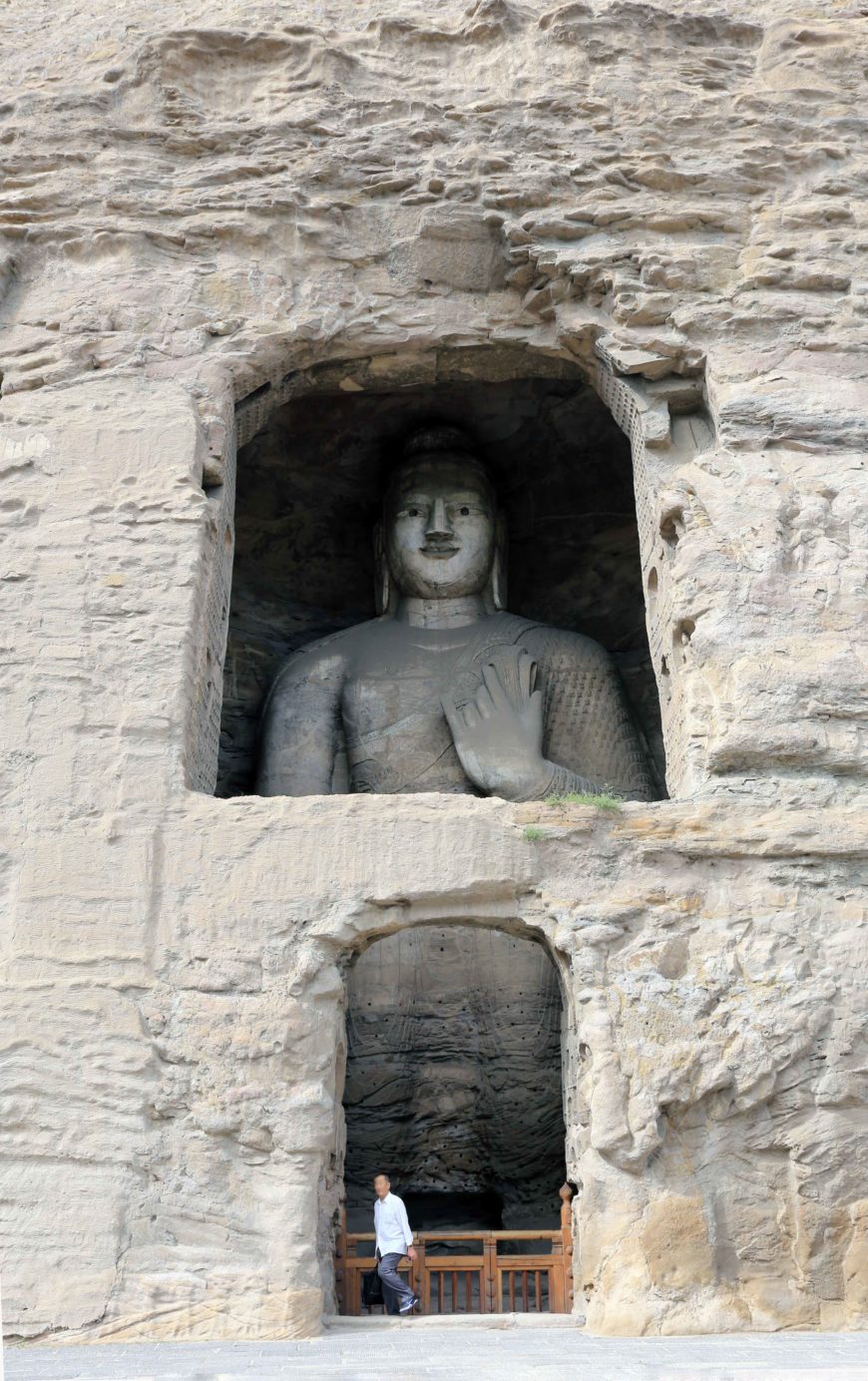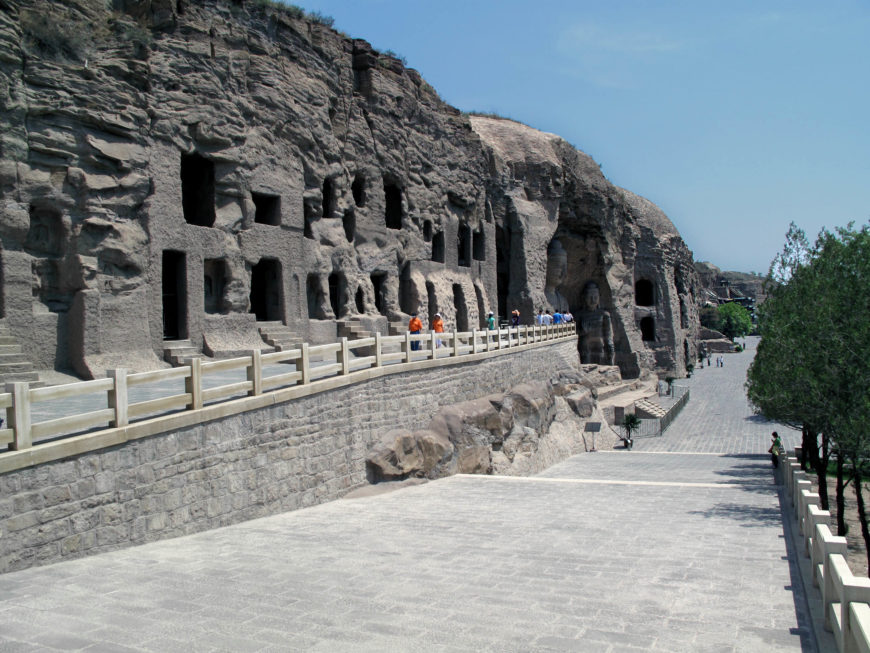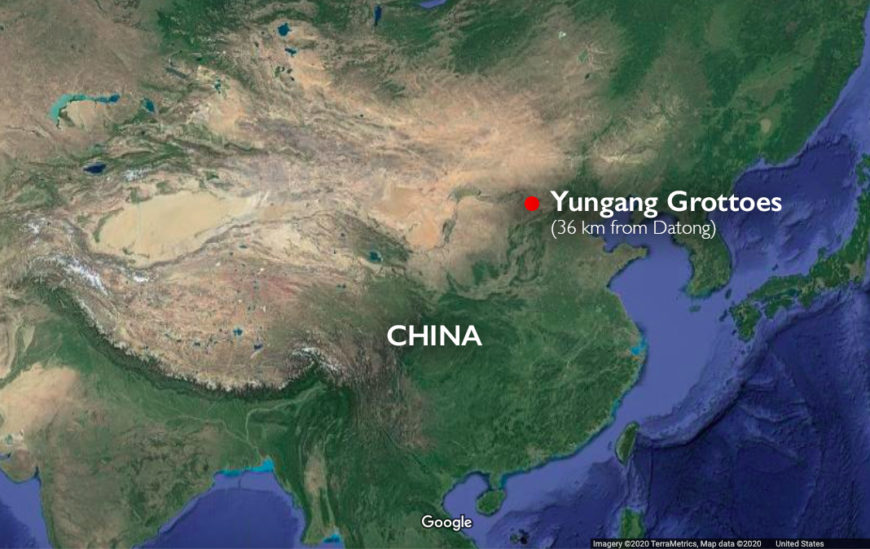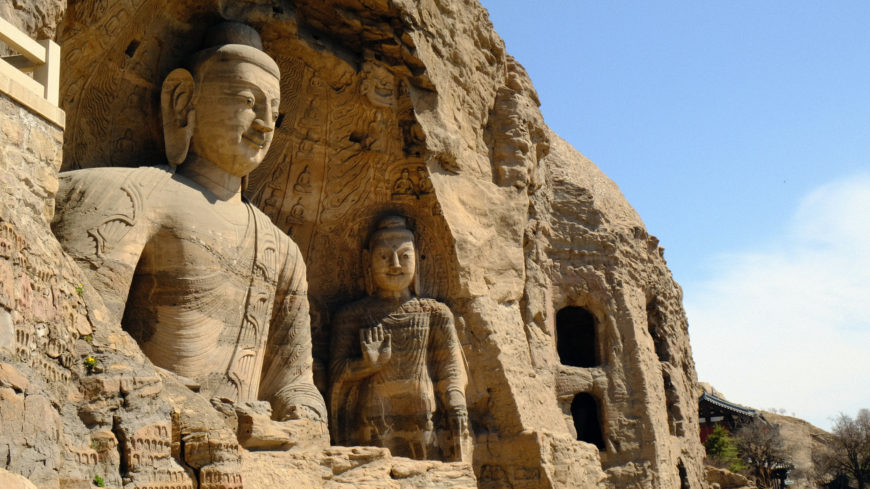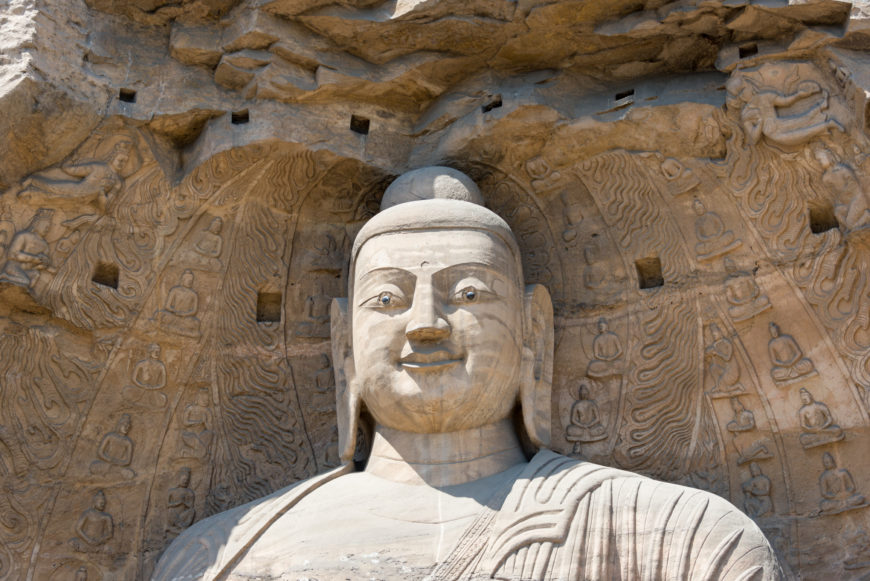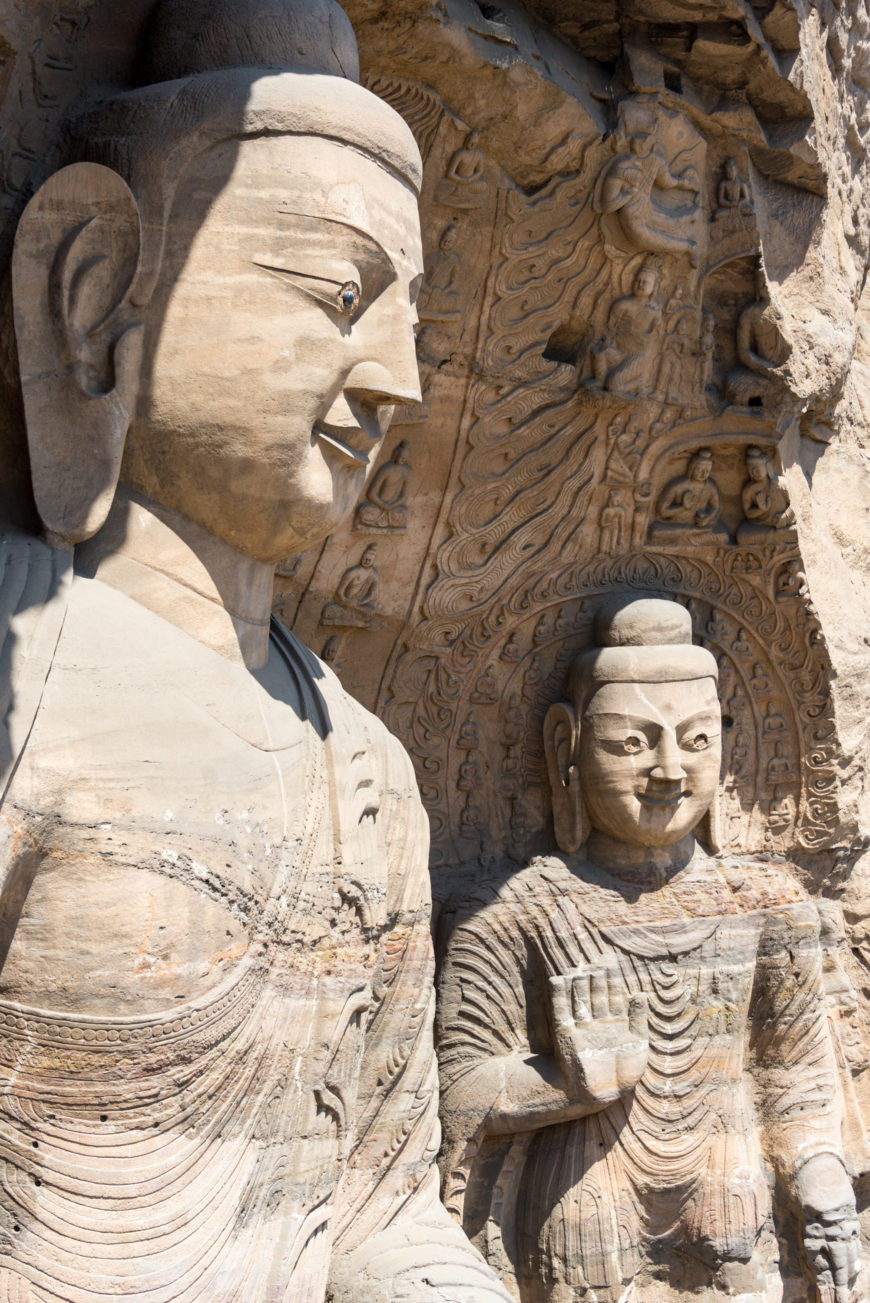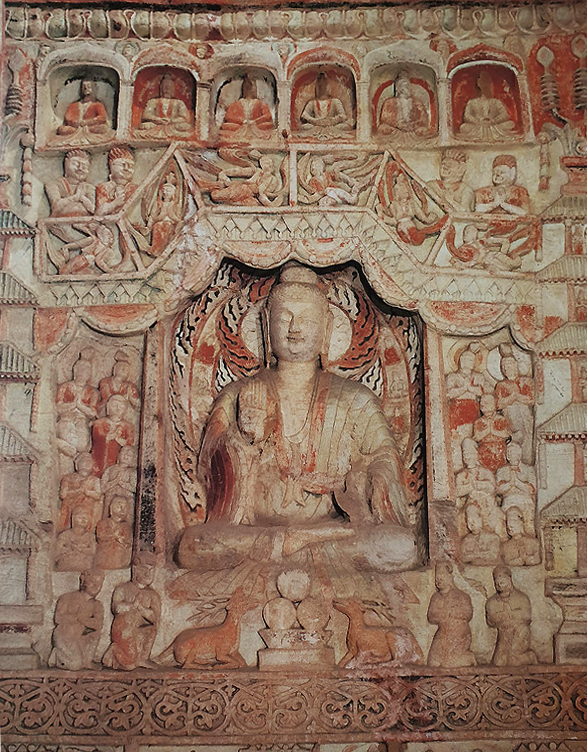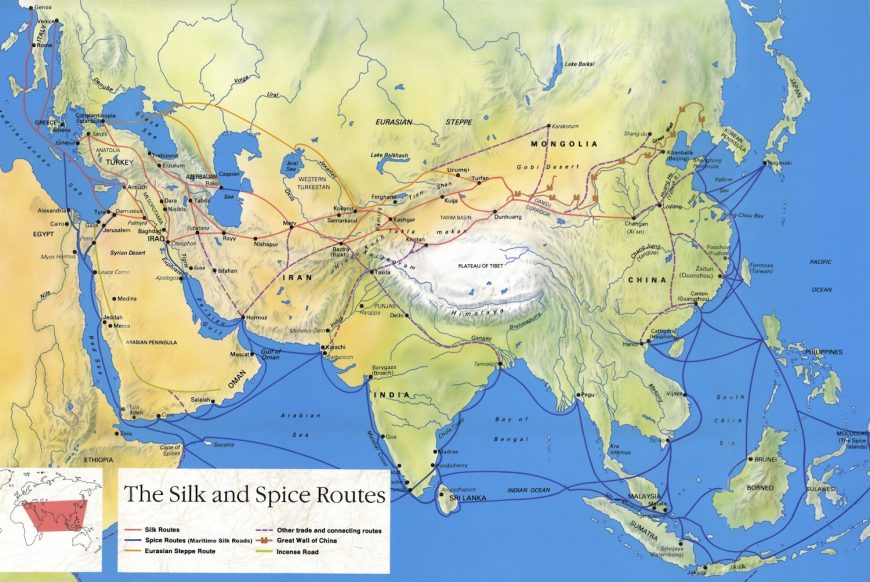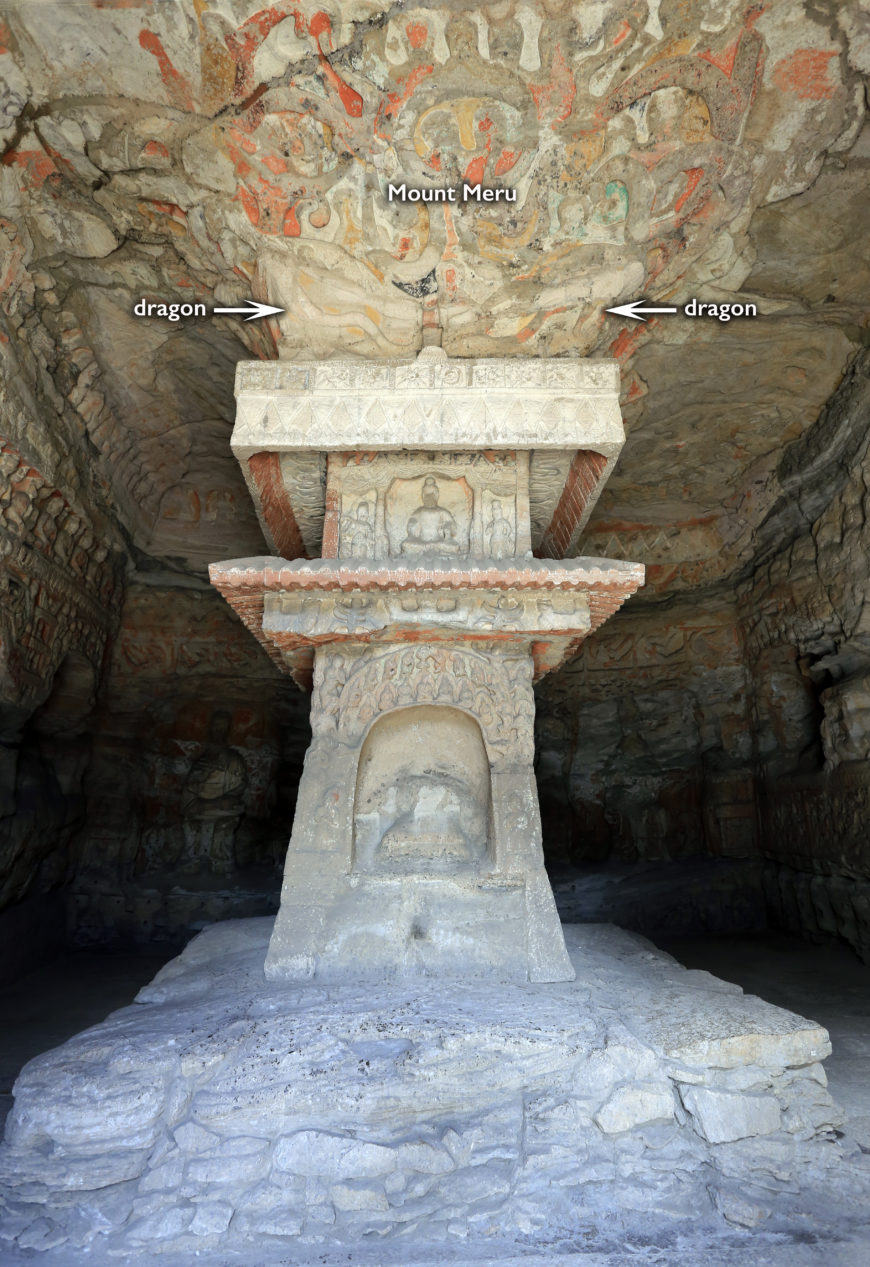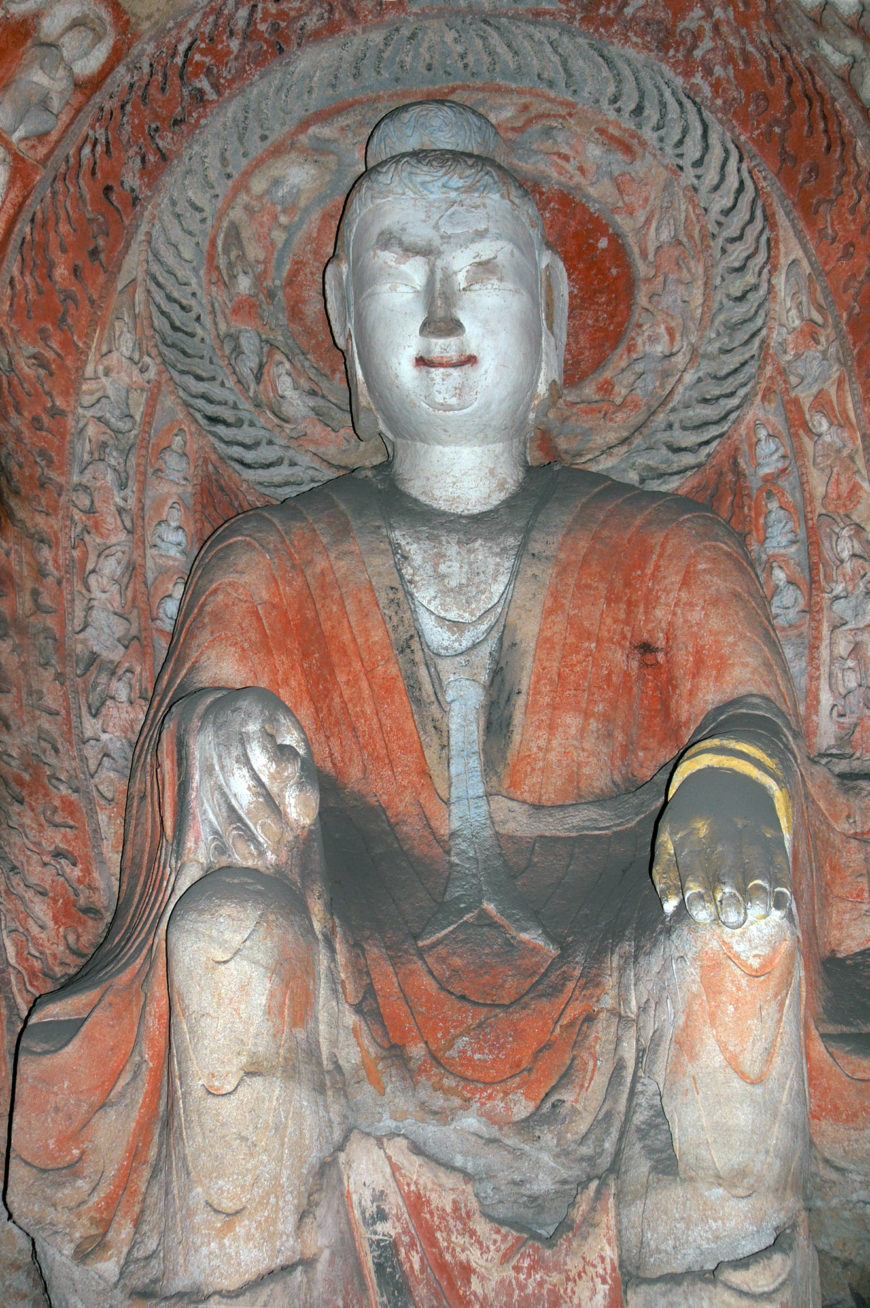Imagine peering into a cave and seeing a monumental carved Buddha peer right back at you. This is only one of many sculptures of Buddhist subjects found in rock-cut complexes that survive today in parts of Asia where Buddhism spread, including China.
Yungang 云冈 is among the earliest rock-cut Buddhist cave-temple complexes in China, with over 45 major caves and over 200 smaller niches. The site itself extends for more than half a mile along a south-facing cliff and is located about 18 kilometers (a 30-minute drive) west of the city of Datong in Shanxi Province.
Yungang is an enduring legacy of Chinese Buddhist art and a UNESCO World Heritage Site. It is renowned for its magnificently carved cave-temples and polychromatic sculptures. It demonstrates how various artistic traditions of South, Central, and East Asia (southern China) were integrated and remixed to create something new. The Yungang cave-temples (sometimes called the Yungang Grottoes) were also an important venue for rulers to construct and communicate their political authority.
The five caves of Tanyao and their imperial patronage
The construction of Yungang began with a set of five cave-temples (today these five are numbered 16 to 20) at the west end of the cliff. The caves were imperial commissions of the Northern Wei dynasty around the year 460 C.E. The Northern Wei dynasty ruled from their nearby capital Pingcheng (present-day Datong).
The Northern Wei rulers were of the Tuoba clan from northern China and were not Han Chinese (China’s dominant ethnicity). The Northern Wei rulers unified northern China in 439 C.E. after approximately two centuries of political turbulence and intense social change. Importantly, they established Buddhism as the state religion. The royal family and their court elite were earnest patrons of Buddhism. The dynasty’s capital, Pingcheng, became the most important Buddhist religious and artistic center in China.
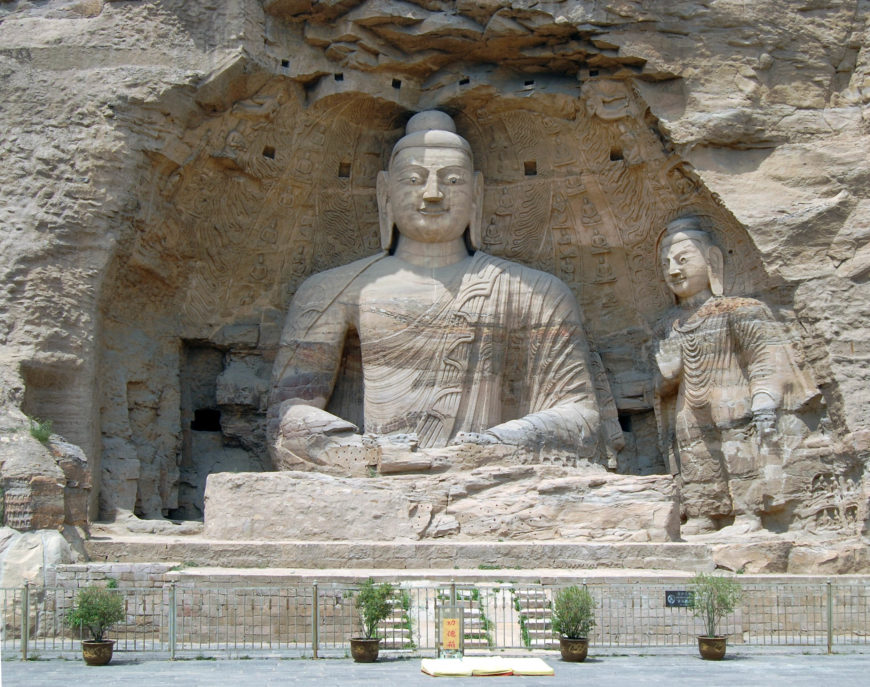
Buddha, Cave 20, Yungang, Datong, China (photo: Marcin Białek, CC BY-SA 4.0)
Caves 16, 17, 18, 19, and 20 each contain a colossal Buddha as the central icon. Cave 20, for example, houses a gigantic seated Buddha in a meditation posture, with a standing attendant Buddha at one side. There was probably another attendant Buddha on the other side but it has been lost along with the cave’s exterior wall.
The main Buddha measures roughly 13 meters in height. He has plump cheeks, a thick neck, elongated eyes, a sharply cut nose, slightly smiling lips, and broad shoulders, all of which produce a solemn appearance.
The well-preserved halo behind the main Buddha is composed of an outer band of flame patterns and two inner bands decorated with seven seated Buddhas of miniature size. The robe features zigzag patterns on the edge. The right shoulder of the main Buddha is left exposed, whereas the standing attendant Buddha on the east wall wears a robe that covers both shoulders with a high neckline.
Historical records recount that Tanyao, a renowned monk cleric with official ranks, advised Emperor Wencheng to undertake construction of five cave-temples (Caves 16–20) to commemorate the five founding emperors of the Northern Wei dynasty. Claiming that the emperor of Northern Wei was the living Buddha, this project declared the emperor’s political and spiritual legitimacy, and strengthened the rule of the imperial family.
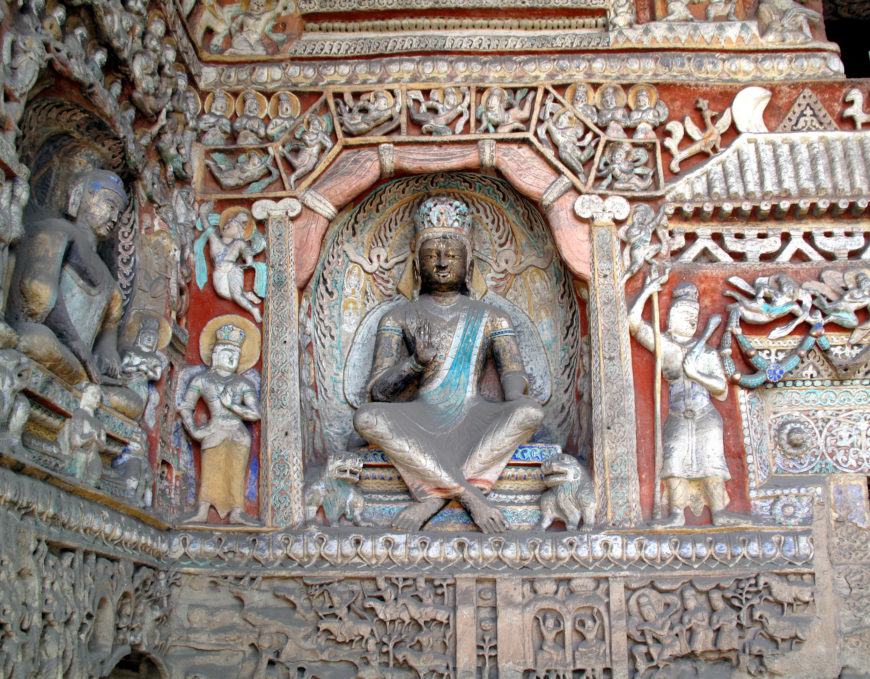
The cross-legged Bodhisattva Maitreya, on the east wall of the antechamber of Cave 9, phase II, Yungang Grottoes, Datong, China (photo: G41rn8, CC BY-SA 4.0)
The paired caves and the major development at Yungang
Beginning roughly a decade after the initial commission, the imperial projects at Yungang advanced to a second phase that lasted from c. 470s until 494 C.E. In contrast to the monumental Buddha found in Cave 20, the interior of the second-phase cave-temples are decorated with reliefs that depict Buddhas, bodhisattvas, and other divine figures in various scales and configurations.
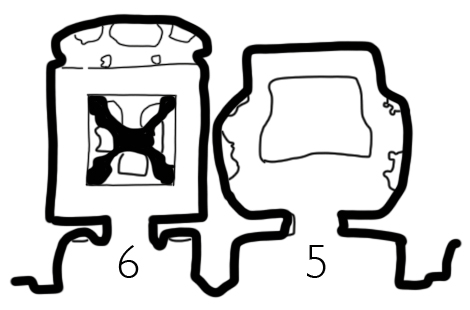
Plan of paired caves 5–6 at Yungang, c. 480s–490s C.E. Drawing adapted from Su Bai, “Pingcheng shili de jiju he ‘Yungang moshi’ de xingcheng yu fazhan” 平城實力的集聚和“雲岡模式”的形成與發展, in Zhongguo shikusi yanjiu 中國石窟寺研究 (Beijing: Wenwu chubanshe, 1996), 114–144.
One of the most distinctive features developed in the second phase of construction are paired caves—two adjacent caves featuring a similar architectural plan and pictorial program. The paired cave-temple layout is understood to symbolically represent the reign of two coincident rulers: Emperor Xiaowen (471–499 C.E.) and Empress Dowager Wenming (442–490 C.E.). The use of paired cave-temples became another means to demonstrate the dynasty’s imperial power.
The two Buddhas in a niche are on the central pillar in Cave 6, Yungang grottoes
The paired Caves 5 and 6 are among the most lavishly decorated cave-temples at Yungang. Cave 6 has an antechamber and a square main chamber supported by a central pillar (see the full cave 6 in 3D). A square clerestory (window) is opened right above the passageway to the main chamber to let in light (although it is hard to see in photos or the 3D image).
In the main chamber of Cave 6, the east, south, and west walls are divided vertically into three main registers that include complex pictorial programs (the north wall features a large niche housing a trinity of Buddhas that are later repairs). We find seated Buddha figures and scenes from the Buddha’s life throughout the chamber. Depictions of the historical Buddha, who was believed to live in the Ganges River basin during the 6th century B.C.E., derived largely from Buddhist texts. The Buddha’s biography details the course of his life from birth to enlightenment, and eventually to nirvana, the final extinction. The life of the Buddha was among the most popular themes for artistic representation throughout the Buddhist world.
One scene from the Buddha’s life (at the southern end of the east wall) shows the First Sermon of the Buddha at Deer Park, identifiable by the depiction of a pair of deer on the Buddha’s throne. We see a canopied standing Buddha flanked by two standing bodhisattvas and a myriad of worshippers in the background. Just below the standing Buddha niche, a seated Buddha with his right hand raised (the fearless gesture) can be seen in a trapezoidal-shaped niche flanked by two five-story pagodas (just visible at the edges of the scene in the photograph). Worshippers either kneel in front of the throne or stand facing the Buddha on his two sides.
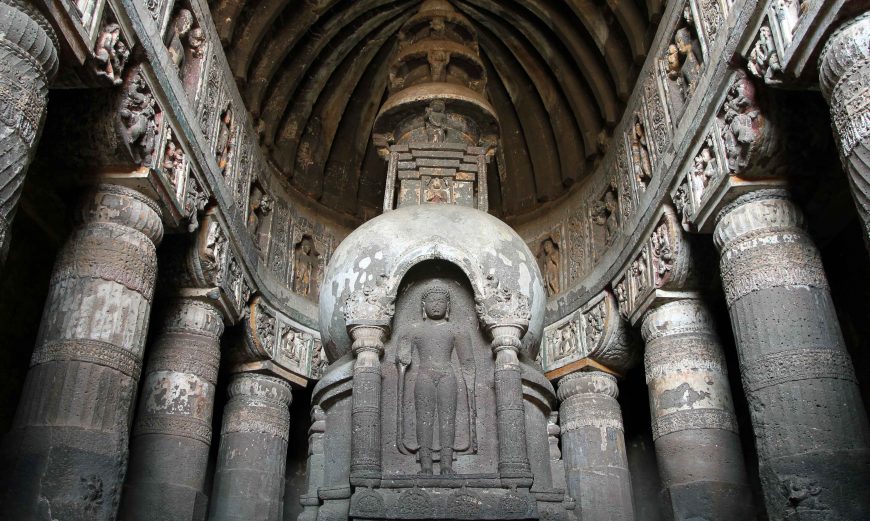
Ajanta, Cave 26, (photo: Arian Zwegers, CC: BY 2.0)
Rock-cut cave-temples
Rock-cut cave-temples first appeared in western India in the 1st century B.C.E. There are two basic types: apsidal-shaped (semicircular) chaitya (sanctuary, temple, or prayer hall in Indian religions) and vihāra caves where monks resided—both of which we find at places like the caves of Ajanta, India. Both types were transmitted eastwards to Central Asia up to the 5th century with modifications of the structures. At Yungang, the sanctuary type was further adapted into a square shape that houses a central pillar in the middle, as we find in Cave 6. At the same time, a number of architectural features find their precedents in Goguryeo tombs from present-day northeastern China and North Korea.
But what facilitated these different traditions coming together at Yungang?
Transmissions and transformations of artistic styles
Yungang was a hub where multiple artistic traditions of South Asia, Central Asia, and pre-Buddhist China synthesized into something new. This was made possible by the Silk Road, a network of ancient trade routes linking East Asia with the rest of Eurasia. Goods and ideas have been exchanged along the Silk Road since at least the second century B.C.E. Central to the economic, cultural, and religious interactions between different parts of Eurasia, the Silk Road tied the Northern Wei territory to the sacred heartland of Buddhism in South Asia, and to Central Asian kingdoms that promoted Buddhist teachings.
A primary factor facilitating the encounter of these varied traditions was the gathering of human resources and materials from different regions. In the 430s and 440s, the Northern Wei court issued decrees that relocated artisans and monks from its conquered lands to the capital city of Pingcheng. The concentration of people and craftsmanship in the capital led to the artistic flourishing of well-executed Buddhist monasteries, cave-temples, sculptures, and murals. Eminent monks who were active in Pingcheng had also engaged with religious activities in other urban centers such as Chang’an and Wuwei, and maintained close ties with Central Asian Buddhist communities.
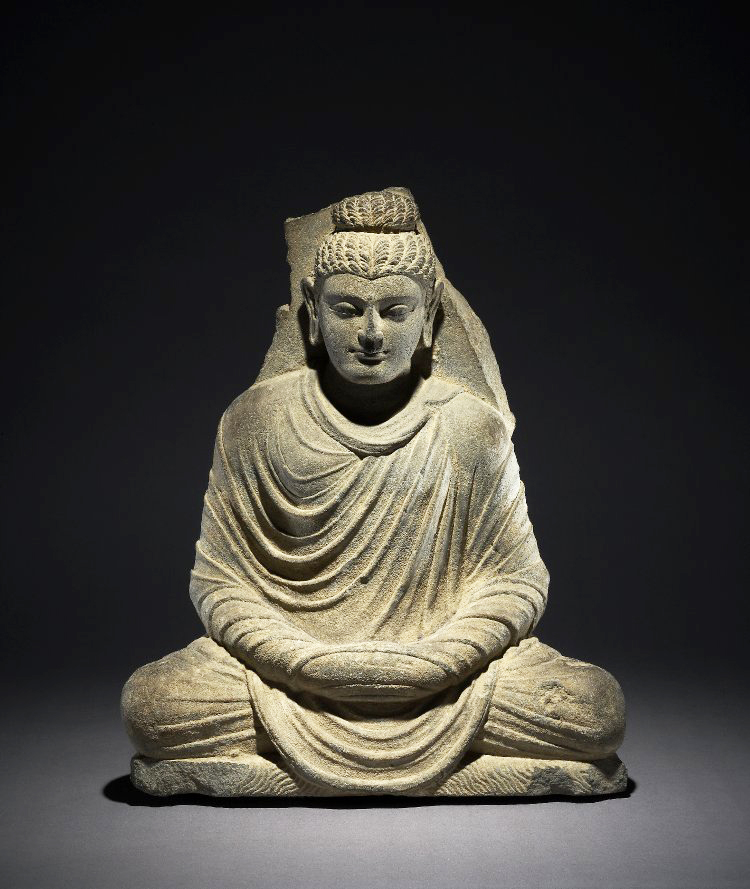
An iconic form of the Buddha, 2nd–3rd century C.E., Kushan period, Gandhara, schist, 19.76 x 16.49 x 4.56 inches (The British Museum)
Just as the form of the rock-cut cave-temples was adapted from earlier traditions in South Asia, statues and reliefs at Yungang exhibit strong stylistic and iconographic affinities with earlier Buddhist art traditions from northwestern India and Central Asia. For instance, the main colossal Buddha images in Caves 16 to 20 feature a round face, with a gentle, calm expression that creates an impression of sanctity, and a robe style that clings tightly to the body yet is rendered with schematic patterns. All of these features echo the aesthetics found in previous traditions, especially the Buddhist sculptures in Gandhara, a Buddhist center located in present-day northwest India and Pakistan.
Yungang art exerted influence, in turn, on Central Asian cave-temples starting in the later 6th century, such as Dunhuang, indicating that a dynamic exchange took place among the major cultural centers along the Silk Road.
Sinicization reforms under the reign of Emperor Xiaowen
One of the new developments shown at Yungang that would have a long-lasting effect on Chinese Buddhist art was Sinicization, a process of adapting non-Chinese traditions into Han Chinese culture. In Cave 1, between the canopy of the central pillar and the ceiling we find intertwined dragons surrounding mountains that represent Mount Meru (the sacred mountain considered to be the center of the universe in Buddhist cosmology). The design shows strong influence of the pre-Buddhist Chinese tradition in two aspects. First, the dragons are depicted with typical Chinese conventions—a snake-like curving body with four legs. Mount Meru was not related to dragons in pre-Chinese Buddhist art traditions. The incorporation of dragons in the design reveals an integration of the motif’s symbolic reference to a spiritual life force in traditional Chinese beliefs.
In Cave 6, we also see Sinicized traits in a new style of the Buddha’s monastic robe, which features loose drapery that falls around the body and clothes the Buddha entirely instead of the earlier style that clings closely to a partly exposed body. The new style finds parallel in the contemporary dress of court officials.
Overall, these new styles and motifs were a response to the political reform of Sinicization promoted by Emperor Xiaowen and Dowager Wenming during their reign in the Taihe era (477–499 C.E.). The reform aimed at legitimizing the Northern Wei regime, built by non-Chinese nomadic groups, as an imperial Chinese dynasty, and promoting a greater sense of conformity throughout the empire.
The legacy of Yungang
Despite the move of the capital to Luoyang in 494 C.E., constructions at Yungang continued for another three decades. Cave-temples of this phase are much smaller in size than at the earlier western end of the complex. Over half a millennium later in the 13th century when Yungang was the capital of the Liao Dynasty, Yungang witnessed another era of glory, with restorations of the caves and installation of wooden structures attached to their façades. Yet it was only a temporary phenomenon. The site later stayed silent for centuries until its early 20th-century rediscovery along with other major cave-temples by foreigners on expeditions.
Modern scholarship about the history and the art of Yungang Cave-temples has continued to provide new information about the site. The most recent archaeological excavations at Yungang unearthed the remains of a monastery dated to the Northern Wei dynasty above the western section of the cliff. The well-preserved foundations of courtyards, the central stupa (a sepulchral monument that refers to the Buddha), residential cells for monks, and objects continue to enrich our understanding of the site as a significant religious center from the 5th century.
Yungang Grottoes (UNESCO/NHK)
Additional resources:
Read about the Longmen caves in Luoyang, China, also made in the Northern Wei dynasty
Soper, Alexander C. “Northern Liang and Northern Wei in Kansu.” Artibus Asiae, no. 2 (1958): 131–64.
Steinhardt, Nancy S. Chinese Architecture in an Age of Turmoil, 200–600. Honolulu: University of Hawai’i Press, 2014.
Tsiang, Katherine R. “Changing Patterns of Divinity and Reform in the Late Northern Wei.” The Art Bulletin 84, no. 2 (2002): 222–245.
Yi, Lidu. Yungang: Art, History, Archaeology, Liturgy. London and New York: Routledge, 2017.

